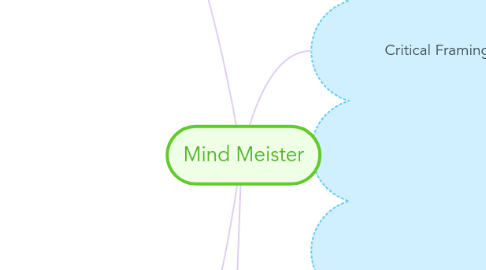
1. References
1.1. Mind Meister. (2014). Mind meister. Retrieved from http://www.mindmeister.com/education
1.2. Australian Curriculum, Assessment and Reporting Authority. (2013). General capabilities in Australian curriculum. Retrieved from http://www.australiancurriculum.edu.au/GeneralCapabilities/Pdf/Overview
1.3. Australian Curriculum, Assessment and Reporting Authority. (2014). Australian curriculum history year 6. Retrieved from http://www.australiancurriculum.edu.au/humanities-and-social-sciences/history/Curriculum/F-10?layout=1#level6
2. Link to Australian History map
2.1. http://www.mindmeister.com/444590533?f=email_share_map&utm_medium=email&utm_source=share_map
3. Overt Instruction
3.1. How does it work?
3.1.1. Process
3.1.2. Create a mind map topic
3.1.2.1. This can be anything, a question, a statement or a subject
3.1.3. Chose the important things you want to explore in the mind map
3.1.3.1. Who, what, when, where, why, etc
3.1.3.2. How, Want to Know, Learnt, etc
3.1.3.3. Any questions you have about the topic
3.1.4. Expand the knowledge in each exploration point with more information
3.1.4.1. Collect and record information which answers the questions asked in the previous step
3.1.5. Continue to collect and record information which provides more understanding to the main mind map topic
3.1.5.1. This adds more to the big pictures and helps pull the ideas together
3.1.6. Choose to collaborate with another student or a number of students by sharing a map
3.1.6.1. This means students can chose to work within a collaborative environment and add specific people to their mind map
4. Critical Framing
4.1. What is it?
4.1.1. Mind Meister is the market-leading collaborative online mind mapping software solution.
4.1.1.1. Launched in 2007
4.1.2. An information Hub of which students and teachers can use to record research and key information for any subject area
4.1.2.1. This can either be created previously for a more scaffolded learning experience or can be used for students to use their research abilities
4.2. General Benefits
4.2.1. Uses
4.2.1.1. Brainstorming collaboratively
4.2.1.2. Plan a trip
4.2.1.3. Create business plans
4.2.1.4. Structure data
4.2.2. Cost
4.2.2.1. 30 days free trial - 3 mind maps
4.2.2.2. Edu Personal - $18/6 months
4.2.2.3. Edu Pro - $30 per user/ 6 months
4.2.2.4. Edu Campus - (20+ users) $6 per user/ 6 months
4.2.2.4.1. 20 users - $120/6 months
4.2.3. Extras
4.2.3.1. Can store vast amounts of information
4.2.3.2. User friendly
4.2.3.3. Can be used online and offline
4.2.3.4. Mapping can be shared and exported in other formats - PDF, Word...
4.2.3.5. Works in collaboration with Google
4.2.3.6. Can be used on mobile devices - iPad, iPhone, Android...
4.3. Benefits
4.3.1. Teacher
4.3.1.1. Records individuals contributions
4.3.1.1.1. For group work, teachers are able to monitor students, production, process and progression...
4.3.1.2. Manage student access - group admin can grant and revoke access to mind maps
4.3.1.3. Caters for different learning needs and styles
4.3.1.3.1. Presents information visually
4.3.1.3.2. Caters for big picture thinkers
4.3.1.3.3. Fosters creativity
4.3.1.3.4. Case Study
4.3.1.4. All changes are recorded and a history kept
4.3.2. Student
4.3.2.1. Mind maps help bridge school and home activities to raise student achievement
4.3.2.1.1. Students are able to access their maps wherever they are
4.3.2.1.2. Involves parents as they are able to see the progress and work of students
4.3.2.2. Security - private, shared or public mapping
4.3.2.2.1. Caters for individual and group mapping
4.3.2.3. Chat format
4.3.2.3.1. When working within a group, group members are able to converse while still mapping
4.4. General Capabilities
4.4.1. Literate
4.4.1.1. Comprehend texts
4.4.1.2. Interpret and analyse texts
4.4.1.3. Compose texts
4.4.1.4. Use knowledge of text structures
4.4.1.5. Understand how visual elements create meaning
4.4.2. Numerate
4.4.2.1. Interpret maps and diagrams
4.4.2.2. Interpret data displays
4.4.3. Digital
4.4.3.1. Generate ideas, plans and processes
4.4.3.2. Collaborate, share and exchange
4.4.3.3. Manage digital data
